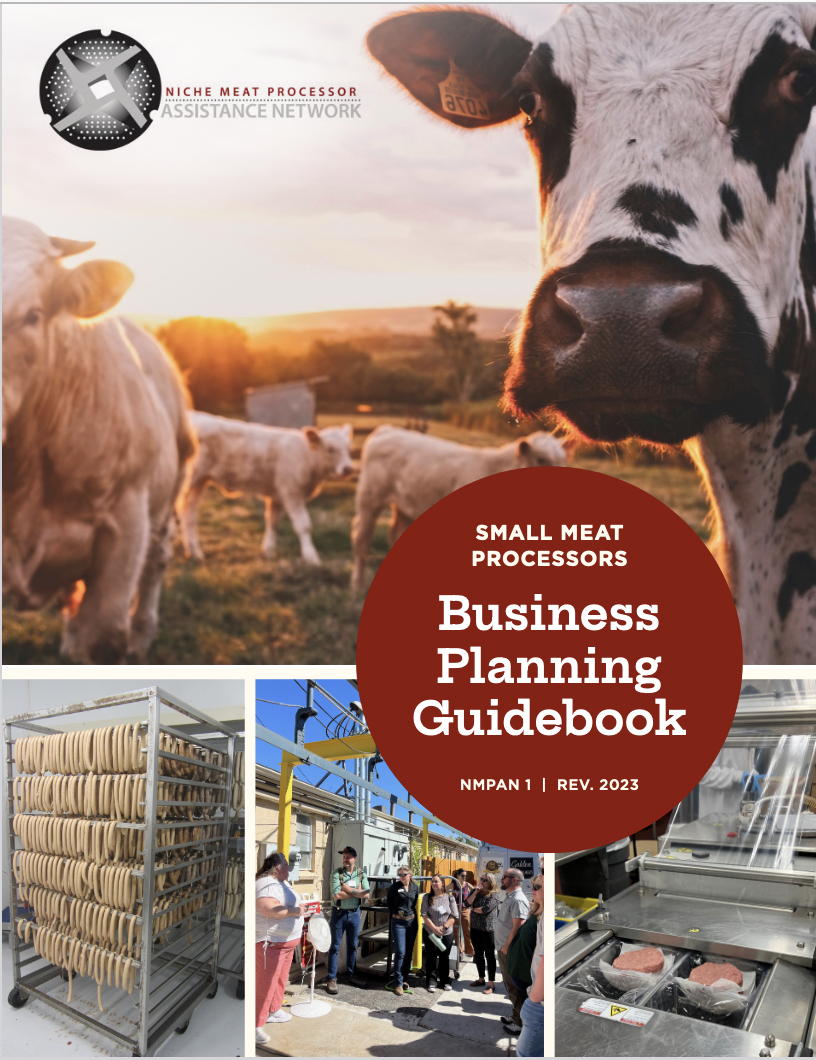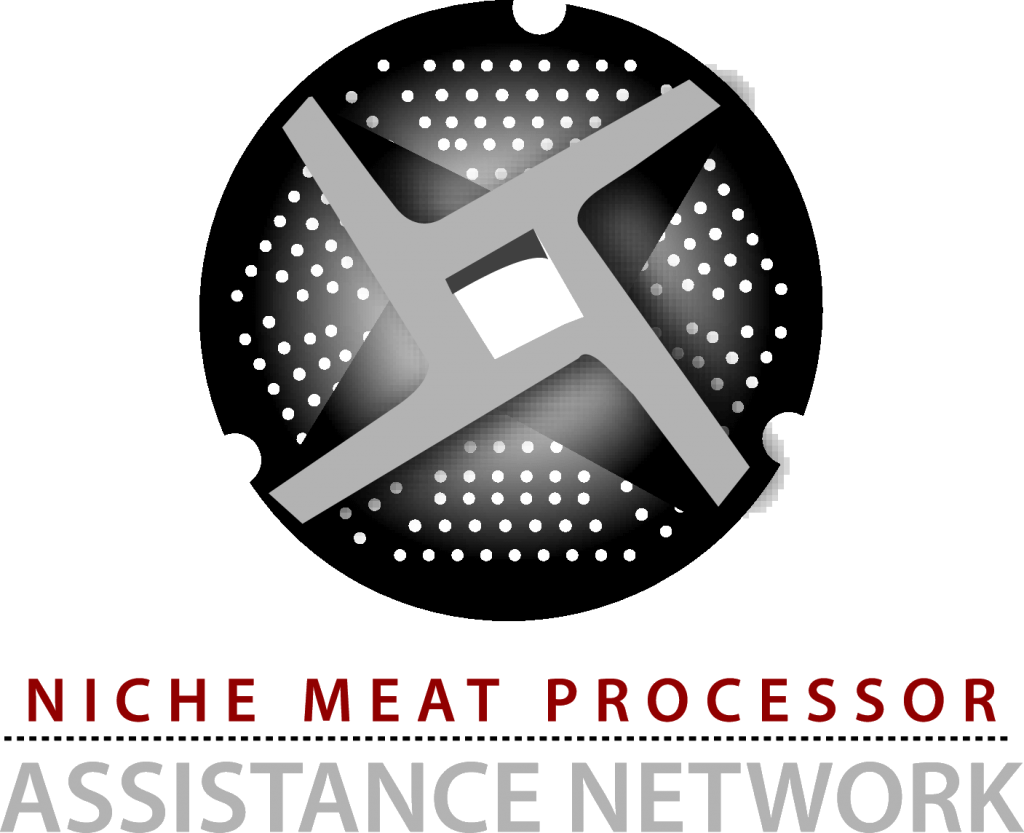What’s on this page?
Here you’ll find resources for planning a new meat processing business or expanding an existing one. The economics of small-scale meat processing are tough. It is a capital-intensive, thin-margin, high-risk business. A solid business plan is absolutely essential in this industry. There are several links here to help you get started:
Q: How do I write a business plan for a small-scale meat processing facility? Are there sample plans I can look at? What about spreadsheets?
- NMPAN’s Small Meat Processors Business Planning Guidebook
- Small Meat Plant and Marketing Company Business Plan Models
- CISA Tools: Cash Flow Template and Feasibility Template for Small Plants
- Oklahoma State University: Financial Planning Template for a Small Meat Plant
- Cost Analysis: Are You Making Money?
- Strategies to Increase Throughput
- What business structure is right for me?
Q: We want to do a feasibility study for our region. Has one already been done? Are there examples we can look at? Do we even need our own study?
Q: I want to hear from other processors about their businesses!
NMPAN’s Small Meat Processors Business Planning Guidebook
Every business needs a plan, whether you’re just getting started or changing course after many years. This recently updated guide walks you through a basic business plan, from a processor looking to upgrade and expand their facility. It contains detailed financial projections based on 2023 costs and provides suggestions for planning other plant configurations.
PLEASE NOTE: This guide does NOT provide an easy answer to the question of how many head of livestock you need to process at what price to have a “successful” business. There is no one solution. Figure out what it costs you to run the plant, figure out how many head of livestock you can source, and divide costs plus margin by that number of livestock to get your price.
All three variables can be manipulated — increase number of head, decrease costs (start-up and operating), increase prices — but the end result must be a balanced equation. And remember that price feeds back on head, because if you raise prices, demand for your services can go down and vice-versa.
Download the new 2023 Guide here!
Download the 2011 Guide here
Model Plan Cash Flow Template (Year 1)
This template (in Excel) contains the year 1 cash flow projections for the sample business plan featured in the guidebook. Not all cost/revenue categories will be applicable to your plans, but this will show you one way to set it up. Read the instructions page first (tab 1 of the workbook). Please note that this template was created in 2011 so the numbers are out of date. Use your own numbers.
Small Meat Plant and Marketing Company Business Plans
This link will take you to a pair of model business plans for a small, USDA-inspected meat processing plant and linked meat marketing company, including a multi-part business and marketing analysis.
The plans describe a plant that provides fee-based slaughter and processing services to livestock producers and manufactures processed meats for sale to wholesale or retail customers. It can harvest and process ~25 to 32 beef cattle per week and a similar amount of hogs and lambs/goats and would employ 7 to 11 full-time workers.
The plans were prepared by Food and Livestock Planning, Inc in 2011 as part of a project funded by USDA Rural Development to examine processing and marketing options for the South Coast region of Oregon.
CISA Cash Flow Template for a Small Meat Plant
This cash flow template tool, created by Community Involved in Sustaining Agriculture (CISA), can help you develop your own cash flow model and explore business options.
CISA designed the template in 2008 to test the financial feasibility of establishing a small-scale, low-tech, mixed species slaughterhouse and processing facility in Western Massachusetts. CISA partnered with a small group of farmers to estimate cash flow inputs for building or renovating a small-scale slaughter and processing facility. Based on this, they developed a cash flow projection and Profit and Loss Statement, in template format for others to use.
The template, detailed instructions, and the full feasibility study, “Demand and Options for Local Meat Processing,” are on the CISA website.
CISA Feasibility Template for a Small-Scale Meat Processor (cut & wrap only)
This feasibility template was designed to help test the economic viability of establishing a small-scale meat-processing facility. It assumes the facility will not slaughter animals, but will instead receive whole animal carcasses, halves, or quarters, which will then be further processed. This template can provide a quick analysis of a potential business, as well as the relevant criteria to consider. The template, however, should not be the sole tool used in your determination.
The template was developed a part of CISA’s 2013 study on expanding meat processing capacity in Western Massachusetts. You can find the study (and more) here, on CISA’s website.
Oklahoma State University Planning Template for a Small Meat Plant
OSU developed this feasibility template, released in 2012, to guide potential plant operators through financial planning for construction and/or operation of a small, multi-species meat processing facility. Lead author is Dr. Rodney Holcomb, with assistance from Dr. Phil Kenkel and Mr. Kyle Flynn.
- Template: http://www.fapc.biz/files/smallmeatplant_feasability.xls
- Instructional Video: http://www.youtube.com/watch?v=hJcnL0KY864&feature=related
Cost Analysis: Are You Making Money?
How do you know if you’re making money? And what can you do about it if you’re not? Most small processors (like most small businesses) don’t fully understand why they are or aren’t making money and what they can do about it. On this page, based on a NMPAN webinar given by Arion Thiboumery, co-founder of the Niche Meat Processor Assistance Network and a processor himself (Lorentz Meats, Vermont Packinghouse), we introduce systems to help you sort out which activities in your plant are most profitable and which are less profitable. Armed with this financial information, you can make decisions that improve your business’s performance.
Research has shown some strategies for increasing profitability for small and very small plants. These include management policies and improving the retail case. See this article by Nick McCann, formerly of Iowa State University, about research showing that targeted education and training for plants can make a significant difference on their bottom line. McCann, N. (2014). Improving profitability for small and very small meat processors in Iowa. Leopold Center Completed Grant Reports. 471.
Strategies to Increase Throughput
Meat processors, like most businesses, work hard to cut costs, hoping to improve their bottom line. But while cost cutting can sometimes improve profits, too often it doesn’t get us very far. So what can? Research with small plants in Iowa indicates that increasing throughput — sales less raw materials — is almost three times more effective at raising profits than cost cutting.
Now, that’s easy to say, but harder to do. Most folks think it’s impossible to put any more meat through their plant. Sometimes that’s true. Yet often small changes can significantly improve your bottom line.
In these short articles, written by Nick McCann with Iowa State University Cooperative Extension, you’ll learn about useful and practical strategies that some small plants have used to increase throughput and profitability.
Business Structure
There are several legal business structures to consider when forming your meat business. There are pros and cons to each. It is best to do your research and then speak to a legal advisor and/or tax accountant before making your final decision. While you can always change your legal structure later along in your business, it’s best to start off on the right foot and not have to change it later. Check out these two tables ( Business structure infographic_KTC.pdf and
Business structure infographic_KTC.pdf and  Business Structures Detail_KTC.pdf ) from Kitchen Table Consultants to get a better sense of the direction you might take when incorporating.
Business Structures Detail_KTC.pdf ) from Kitchen Table Consultants to get a better sense of the direction you might take when incorporating.
Meat Processing Feasibility Studies
Different groups around the country have conducted feasibility studies to learn what kind of processing solution makes the most sense for their area and circumstances. Our summaries of selected studies tell you how the studies were done and what they learned. We give contact info for the authors and links to the full reports.
Meat Processing Planning Webinar Archives
To Build or Not to Build: Lessons Learned from New Processing Ventures
Finding a processor that does what you need, when you need it, can be challenging. Building a new facility to meet that need might seem like a good idea. Sometimes it is, but often it isn’t. On this 1-hour webinar, we discuss what works — and what doesn’t work — when building new processing facilities. Our speakers share lessons learned, with real examples from the field.
Building a Small Meat Processing Plant
Thinking about building a new plant? Want to expand your existing plant? Considering getting into the meat processing business? This 1-hour webinar will help you understand the process and the pitfalls of plant design and construction.
Local Meat Processing: Successes and Innovations
Host: National Good Food Network
Local meat and poultry can’t get to market without a processor, but processors are pulled in many directions: Farmers would like more processing options, but the kind of processing needed depends on the market, the regulations are complex, and even with premium-priced meats, the profit margins are slim.
So how can local meat processing survive … and even thrive? On this 90 minute webinar, Lauren Gwin and Arion Thiboumery, co-founders and co-coordinators of the Niche Meat Processor Assistance Network, share the results of their research on this topic, featuring innovations and lessons learned from successful processors around the country. We also heard from several regional support efforts — in Vermont, New York, and North Carolina — to improve access to local processing.
The Business of Meat Processing: Planning and Profitability
Planning to expand, change, or build a new meat processing business? Trying to figure out how to make your small processing business more profitable? On this 75-minute webinar, business management and planning experts will address these important topics and answer your questions. We will also roll out two new user-friendly guides for small meat processors on planning and profitability.
Cost Analysis: Are You Making Money?
Many meat processors watch their checkbook balances and hope for the best. Some wade through P&L statements looking for answers and often come up short. Most small processors don’t fully understand why they are or aren’t making money and what they can do about it. This hour-long webinar will teach you how to develop systems that will give you the financial information you need to make decisions that improve your business’ performance.



